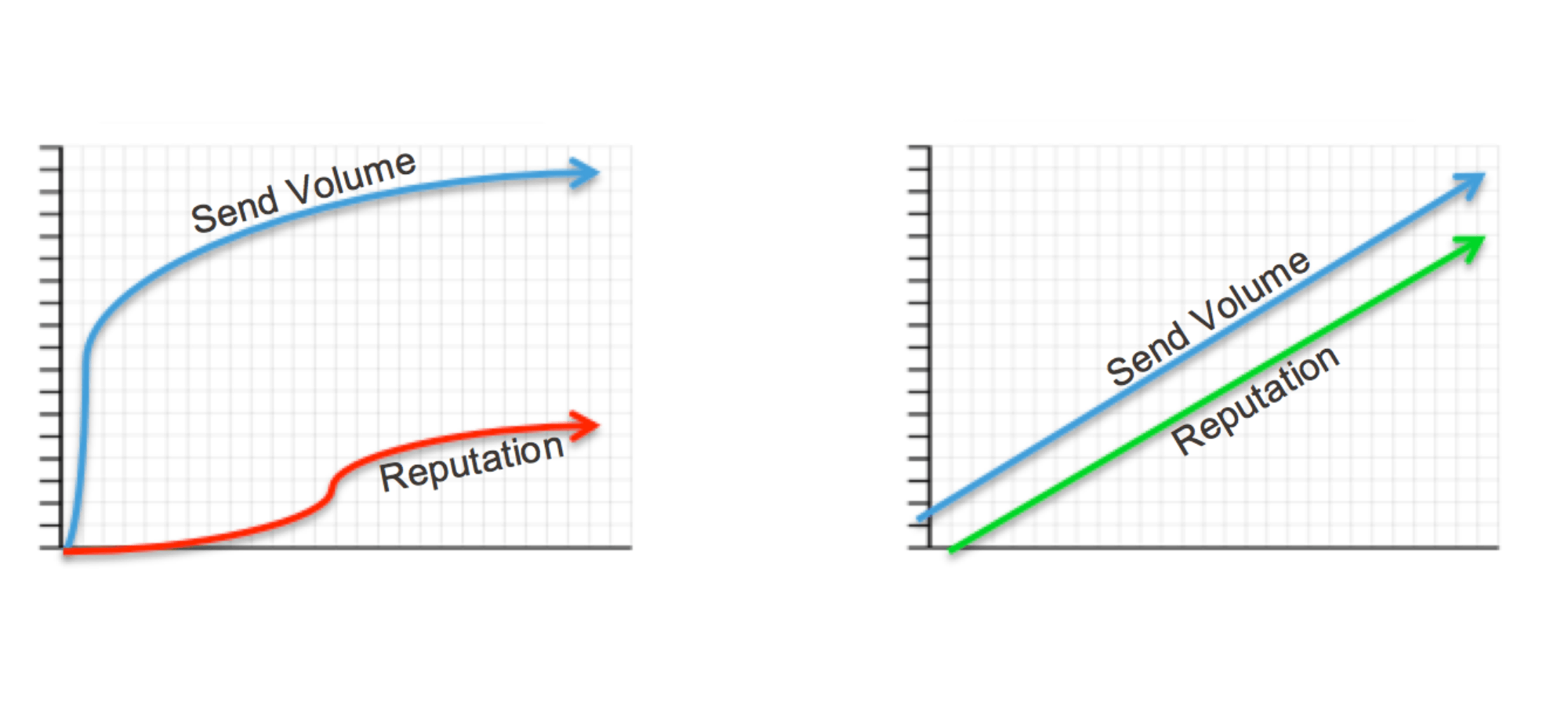BEST PRACTICES
Collection of some fundamental best practices from Inboxing Maestros.
Sender Reputation & Domain/IP Warmup
The purpose of warming up IPs (and, equally important, your sending domains) is to ensure that your new dedicated IP(s) establish a strong sending reputation with the various ISPs where your subscribers have their email addresses. There are multiple factors that can impact your IP/domain reputation, and each ISP may have their own criteria on how they weigh these factors. Because of this, our IP warmup plans try to control three key factors in the process of building up the reputations across all ESPs. These are:
1) Hygiene/quality of email subscriber list (impacts IP reputation)
2) Engagement of users and performance of campaigns (impacts Domain reputation)
3) Volume/consistency of email sending (impacts IP and Domain reputation)
What is a warmup process, why it matters & fundamentals of Reputation?
IP/domain warmup is a process where senders starting to mail off of fresh IPs and domains, gradually ramp up their volumes, while ISPs (internet-service providers) assess the quality of the new mail stream. The goal is to establish a strong sender reputation by slowly ramping up to full volume starting with your most engaged subscribers over a period of time. Typically, this process takes ~4-6 weeks but will vary with each sender depending on a customer’s target volume and engagement.
“IP warming is a pivotal process that can make or break a customer’s ability to successfully reach their customers with email”
Both reputations are important considering that IPs and domains build and maintain separate reputations.
A GOOD WARMUP PERIOD ENSURES THAT YOUR IP AND DOMAIN BOTH BUILD REPUTATIONS WITH ISPs, WHICH INCREASES YOUR CHANCES OF DELIVERING TO THEIR INBOX.
IP/Domain warmup can be one of the biggest pains from migrating from one email service provider to another, so it must be managed strategically and patiently. Basically, there’s no right way to warm up an IP nor is there a specific formula that everyone should follow.
What warming up is about is introducing mail traffic to receiving spam filters in a way that lets the filter know this is a legitimate email stream. This means sending small but regular amounts of mail that recipients interact with. As the filters adjust to the amount of mail from that IP, more mail can be sent over that IP. Increase the mail volume over the next few weeks until the desired volume is reached.
ISPs are cautious about the email activity from new IP addresses. Spammers frequently set up new IPs and immediately start sending large volumes of email. That’s why, ISPs look at previous send history from an IP and/or domain when determining whether to accept, block, or filter a message to their customer’s mailbox. New IPs/domains without any previous history are deemed suspicious to ISPs — “What you have done in the past, is a great indication of what you will do tomorrow.” That’s why warmup process helps ISPs distinguish the legitimate senders from spammers.

Domain/IP Warmup Phases & Timeline:
A typical domain/IP warmup takes about 30 days, with an additional couple weeks of active daily monitoring, but this timeline can be slightly shorter or longer depending on the size of the max send, the quality of the subscriber list and performance of the campaigns sent during the warmup, and any potential issues encountered during the warmup that require mitigation (e.g., high spam complaint rate; high bounce rate).
The warming up process will probably take about 30 days. It might take longer (or shorter) depending on:
- The volume of email you send
- The quality of your subscriber list
- How frequently you send
- Past sending practices & historical reputation history
Regardless of the length of a warmup, the process usually involves three phases:
PHASE 1 (Weeks 1-2): Reputation Establishment
Most important phase of warmup, as a poor first couple days in the warmup can set a bad reputation, and it takes much longer to fix a bad reputation to neutral than it takes to take a neutral reputation to good.
PHASE 2 (Weeks 3-4): Reputation Buildup
After the first couple weeks, the audiences will become more substantial, and the focus will be establishing the consistency of the sending cadence and engagement. Typically, deliverability rates stabilize here, but this is where the inbox placement becomes the focus.
Note: If the reputation after Weeks 1-2 is still shaky, the plan may focus on keeping the volume low but attempting to improve the quality of the list being sent to.
PHASE 3 (Weeks 5-6): Reputation Monitoring
Once the buildup process has completed and the target volume has been reached, it is important to continue monitoring and adjusting the sends until a consistent deliverability and inbox placement has been established.
What to expect while warming up a Domain/IP?
During the first week you will have some deliverability problems while the new domain/IP is building a sending reputation, like blocks across the ISPs, Delays/Deferrals, Mail Oscillation at Gmail & Yahoo, Spam folder placement. Depending on the quality of your subscribers and your overall email marketing practices, you may see additional deliverability issues continue during the warmup process. And, once you start ramping up the volumes to build the reputation, you may further face spam trap hits, hard bounces, deferrals, spam complaints.
Once you begin warming up your IPs you can expect some bulking and blocking to occur. It is key to stick with the plan. Below are details of what you can expect and actions to take.
- Bulking at Yahoo, AOL, Gmail: Typically clears up after a few sends with solid positive metrics, but it can take time to get inbox delivery. The key is to keep sending to engaged subscribers.
- Delays & Deferrals: The delays (421 bounces) will retry for 72 hours and if not delivered will bounce as a 5XX with the original 421 error in the bounce record. Delays are normal and will lessen each day as reputation develops. If they are ultimately delivering, there is no concern. However, if they are timing out in large quantities you should back down your volumes to that mailbox provider by tightening up your engagement window.
- Possible blocking by ISPs can occur if the list isn’t engaged enough. The key is to segment carefully and tighten up engagement Again the key is to keep sending.
- It is important to monitor your metrics and adjust the plan accordingly during the warm-up period.
It’s simply to understand this fact that:
If your sending practices and reputation are poor prior to the warmup, a new IP address won't help you increase your inbox placement in most cases. And, if you focus on building a strong foundation for your email program, warmup and deliverability, then ISPs will treat you as a good sender.
Our Top Domain/IP Warmup Best Practices:
To help plan out the domain/IP Warming, the following roadmap & best practices are necessary to ensure the optimal outcome and success for the warmup.
1) Defining the sub-domains nomenclature for a better brand recall
- Avoid using random names like em, comms1, info1, mktg, etc. while naming the sub-domains
- Naming convention should be based on the messaging type and brand recall.
2) Setup your sub-domains based on messaging types:
- Sub-domains get a pseudo reputation effect from the main domain which makes the warmup easier and you can ramp up the volumes if you follow the plan and ensure high engagement rates while controlling spam complaints and bounces.
- Separating your promotional, transactional, newsletters and triggered emails between different, dedicated IP and subdomain/domain combinations will ensure all mission-critical emails get delivered. For e.g.
Promotional: marketing.example.com
Triggered: engage.example.com
Transactional: updates.example.com
Newsletters: content.example.com
3) Authenticate your domains & maintain the domains consistency:
a) SPF: An email-authentication technique which is used to prevent spammers from sending messages on behalf of your domain. The Envelope From / Return Path / Bounce domain / 5321.from domain, where ISP sends the bounce feedback.
b) DKIM: An email authentication technique that allows the receiver to check that an email was indeed sent and authorized by the owner of that domain. This is done by giving the email a digital signature. The value in the d= of the DKIM signature.
c) DMARC: An email validation system designed to protect your company’s email domain from being used for email spoofing, phishing scams, and other cybercrimes. Header.from domain should signed on the Visible From domain (sender domain).
4) Campaign Strategy & Schedule:
- A list of top performing campaigns and content available to use during warming or a campaign calendar.
- Identify if campaigns are time sensitive or can be deployed over multiple days.
- Use the personalized footer instead of generic standard footer
- Keep the unsubscribe link prominent (both at the top & bottom)
- Use the power of personalization in the subject lines, copy, preheaders and CTA
- Different styles of subject lines & doesn’t contain SPAM words (e.g. offer/buy now etc.)
5) User Engagement Breakout:
- Tiering of users should be based on their engagement level (i.e., likelihood to open or click)
- Split the total subscriber w.r.t domains – Gmail, Yahoo, Outlook, Corporate, etc.
- Identify your high-level audience segments:
a) Core audience: Engaged users who have opened or clicked within the last 90 days
b) Lesser Engaged: Users who have not engaged in the last 90 (up to 180) days, though they have engaged at least once with the email channel
c) Unengaged: Users who have not engaged within the last 180-365 days or have never engaged with the email channel, post opt-in
6) Choosing a warmup method:
There are two main ways to go about warming up your IP:
- A ramp-up period in which you send only once to each contact in your list.
- A ramp-up period in which you send a different email message each day to all the contacts you messaged the previous day plus some.
Below, you’ll see the typical approach suggested by most ESPs:

7) Monitoring efforts:
- Monitor performance: Bounce and Complaint Rates, Open, Click Through and Click to Open Rates are all ideal metrics to monitor when you are measuring inbox placement & performance.
- If you start getting warning signs (a falling open rate, for example) with Gmail but not with Yahoo, segment your campaigns by ISP and proceed normally with Yahoo while slowing things down for Gmail. Just as you’d segment and personalize your campaigns for different audiences, you should also segment and personalize your campaigns during warmup for different ISPs.
- After every send, monitor your metrics carefully:
- Have bounce rates increased? Cool your campaign down.
- Got a spike in spam complaints? Cool your campaign and check that your unsubscribe button is in plain sight.
- Are open rates dropping? Falling open rates are a sign that you’re no longer engaging your audience. It can also signal and result in your sender reputation dropping. Post Apple MPP, even if we say open rates are not a reliable metric but it is still helpful to analyse in case of any deliverability issues.
- Setup Google Postmaster & Outlook SNDS for monitoring your reputation 7 spam complaints by your domain/IP
- Utilizing seed list or IPTs to monitor inbox placement is also recommended
- Be sure to monitor performance regularly
- Review performance monthly or quarterly to identify trends
8) Scaling your efforts (After the warmup):
- Once you’ve successfully performed a warmup, your inbox placement will have improved. Compared to the below 50% inboxing before warm-up, you can expect 70-90+% inboxing depending on how good your content was after the process is complete.
- As more emails begin reaching your customer inboxes, the higher your chances of converting users. Even if your conversion rate remains the same overall, more people seeing the email will still result in higher absolute conversions.
- After a good warmup program, you can expect a statistically significant improvement in all of your email metrics combined.
- Continue sending to the same hyper-engaged segment, but up the daily limits on your sending.
- If your metrics remain healthy after this, you can slowly add your less-engaged users to the sending list. Just be sure not to add non-engaged users!
So, in a nutshell - Warming up your IP takes time and requires a lot of patience. It’s worth it, though.
- A proper email warm up program gives a significant boost to your first email campaign.
- Think of it as the trust building phase in real-world relationships. Until a person trusts you, you have limited access to their knowledge and resources. Similarly, ISPs won’t let you access their subscribers without first trusting you.
- But once you build up the required trust, they’re happy to deliver more emails from you to their users because they know your emails are useful to their users.
- You can expect your performance to drop a little during the warm-up phases and that’s normal. Once the program is complete, you can bypass the deliverability issues for as long as you maintain the reputation you’ve gained.
Best practices for maintaining a good email list hygiene for better deliverability
Having a productive quality email list is crucial for email marketing success.
That means, your productive quality email list must contain people who actually want to engage with your email programs—and to keep the list healthy, you must keep suppressing people who aren’t engaging.
In short, if you have a healthy & smaller list of more engaged subscribers, you can reach their inboxes more effectively and eventually build a high-performing email marketing channel.
Let’s understand how a healthy email list impacts your email marketing efforts in terms of deliverability, customer relationships, data, and costs.
A productive email list improves sender reputation—and deliverability
If you have a good email reputation, the mailbox providers consider you a trustworthy sender and lands your email into the inbox. The higher the email reputation, the higher the likelihood your emails lands in inbox and vice versa.
Mailbox providers calculate an email reputation based on multiple factors, like:
Permission is not a choice. It's a must for your brand if you really want to build a strong, long term subscriber relationship. A good permission focused list building method can help you not only build a quality list but also empower you to gather their preferences for better targeting and knowing about your subscribers.
However, you'll still find subscribers who signed up for your email list may eventually lose interest or move away from your brand or even stop engaging with your emails. And, in such scenarios, when you don’t clean your list regularly, you’re more likely to keep sending emails to unengaged recipients or hit recycled spam traps, that may have many adverse effects on your reputation & deliverability.
Here are a few best practices that you can follow for list hygiene:
If you are struggling to generate results from your email programs, start with your source of acquisition, how they end up in your list, how frequent they engage with your campaigns and how frequent you clean your email list to keep it healthy.
Best practices for your email content
Content plays a very important role in maintaining high email reputation and deliverability. Your email content has a reputation built with mailbox providers. So as an ecommerce brand or store owner, you need to follow good content practices to maintain a good reputation.
As you know, your deliverability depends on the type of email content you send to your audience. Content is not just about sending anything to your audience and expect they engage and convert. It's not just an art but a science. That's why, we always advise our customers to craft their email content carefully as this will not only build a solid foundation for your email engagement but also, your brand value with your customer.
Follow these email content best practices to make sure that mailbox providers allow your emails to hit their inboxes and be seen by your customers:
Contact Us
READY TO UNLOCK PROFITABLE INBOXING GROWTH ON KLAVIYO?
Are we a fit?
Get a free 30-minute consultation with our inboxing growth expert.
No obligation to sign up - come prepared with questions.
Join a newsletter. worth reading.
No fluff, just actionable inboxing growth strategies and email tips & tricks, straight to your inbox.
Your details are 100% secure, we will NEVER spam you.

Ready to Improve?
Get in touch with us to talk about your email challenges, goals & plans today.

ABOUT
Inboxing Maestro™ is an email marketing & deliverability consulting company, that helps permission-focused ecommerce brands send better emails, get emails to the inbox & turn emails into a major revenue source.
Disclaimer: We'll show you the strategies & tactics that can help you to improve your deliverability, email performance, and ROI. Results may vary from individual to individual and company to company. Your results will be impacted by numerous factors not limited to your experience, background, discipline & time you commit to applying the strategies. We strongly recommend you follow email marketing & deliverability best practices end to end, and you should be able to achieve better results. However, we do not guarantee 100% results considering ISP's spam filters getting updated almost every day and your business decisions, you might experience some inconsistencies in your deliverability or reputation impact. We advise you to keep following the best practices and tweak the strategies; their filters will understand and adapt.
Operated remotely from: Dubai, UAE
Contact us: +971-521480144, +91-8484913187
Email us: ceo@inboxingmaestro.com
A website made with ❤️ by Mohsin Farooqui Official
© Copyright. Inboxing Maestro™. All Rights Reserved